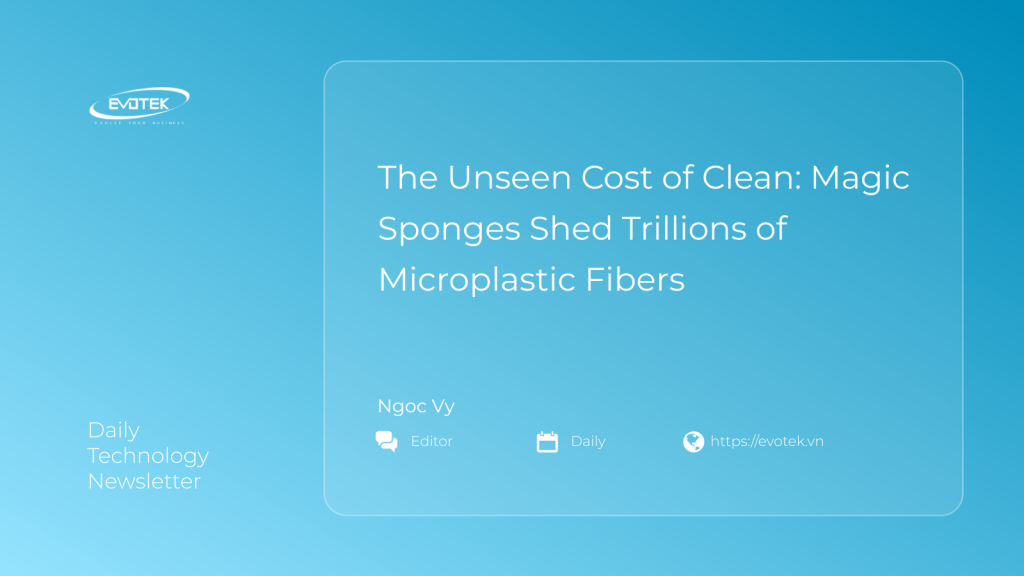Those seemingly miraculous “magic” cleaning sponges, prized for effortlessly scrubbing away tough stains, are revealing a hidden and concerning environmental downside. New research indicates that these popular cleaning tools are releasing an astonishing number of microplastic fibers into our environment, potentially contributing trillions of microscopic pollutants every single month.
The Popularity and Problem of Melamine Sponges
Known for their impressive ability to tackle stubborn marks, scuffs, and grime with just a little water, melamine sponges have become a household staple. Their unique abrasive texture makes them incredibly effective on surfaces ranging from white shoes to painted walls, offering a convenient solution to challenging cleaning tasks.
However, this cleaning convenience comes at a significant ecological price. As these sponges are used, they gradually break down, shedding millions of tiny plastic fibers. A groundbreaking study published in Environmental Science & Technology by the American Chemical Society (ACS) highlights the alarming scale of this issue, suggesting that melamine sponges could be collectively releasing over a trillion microplastic fibers into global ecosystems each month.
Understanding Melamine Foam: Functionality vs. Environmental Impact
The core material of these sponges is melamine foam, a derivative of poly(melamine-formaldehyde) plastic. This polymer forms a rigid, open-cell structure that, when manufactured into a sponge, becomes remarkably lightweight yet highly abrasive – ideal for tackling difficult stains without harsh chemicals. This abrasive quality, however, is precisely what makes them problematic.
With each use, the foam’s delicate structure degrades, liberating minuscule plastic fragments. These microplastic fibers can then easily enter wastewater systems, ultimately making their way into rivers, lakes, and oceans. Once in natural ecosystems, they pose a significant threat, as they can be ingested by marine life and potentially enter the broader food chain.
To deepen the understanding of this widespread pollution source, researchers Yu Su, Baoshan Xing, Rong Ji, and their team conducted detailed investigations. Their work focused on how factors like sponge foam density and the texture of the cleaned surfaces influence the rate of material degradation and the corresponding release of microplastic fibers.
Staggering Scale: Microplastic Release Quantified
In their comprehensive study, the research team acquired melamine sponges from three leading brands. They then subjected these sponges to repeated abrasion against textured metal surfaces, simulating real-world cleaning wear. Their findings revealed a critical insight: sponges made from denser foam exhibited greater durability, degrading more slowly and consequently releasing fewer microplastic fibers compared to their less dense counterparts.
Quantifying the pollution, the team determined that a single gram of worn-out sponge can release approximately 6.5 million fibers. Projecting this data, and assuming a modest 10% average wear-down for all sold sponges, the researchers cross-referenced with Amazon’s August 2023 sales data. Their conservative estimate suggests that a staggering 1.55 trillion fibers from melamine sponges could be released globally every month. It’s important to note that this figure is based on sales from just one online retailer, implying the actual environmental contribution could be substantially higher.
Towards Sustainable Cleaning: Solutions and Recommendations
To mitigate the substantial emission of microplastic fibers from these popular cleaning tools, the research team has put forth several key recommendations:
- For Manufacturers: Prioritize the development of denser, more robust sponges that offer enhanced resistance to wear and tear. Innovations in material science could lead to more durable and less shedding designs.
- For Consumers: Opt for natural, plastic-free cleaning alternatives whenever possible. Exploring traditional cleaning methods or biodegradable options can significantly reduce household microplastic contributions.
- Filtration Systems: Implement effective filtration systems, either at the household level or within wastewater treatment plants, to capture sloughed-off microplastic fibers before they can enter natural water bodies.
This critical research highlights the invisible environmental cost associated with common household products and underscores the urgent need for both industry innovation and conscious consumer choices to combat microplastic pollution.
Reference: “Mechanochemical Formation of Poly(melamine-formaldehyde) Microplastic Fibers During Abrasion of Cleaning Sponges” by Yu Su, Chenqi Yang, Songfeng Wang, Huimin Li, Yiyu Wu, Baoshan Xing and Rong Ji, 6 June 2024, Environmental Science & Technology. DOI: 10.1021/acs.est.4c00846

 日本語
日本語 한국어
한국어 Tiếng Việt
Tiếng Việt 简体中文
简体中文